Page 33 of 53

Chevrolet Camaro High Performance Owner Manual Supplemen (GMNA-
Localizing-U.S./Canada/Mexico-11348335) - 2018 - CRC - 4/5/17
32 Driving and Operating
Limited-Slip Differential
The Electronic Limited-Slip
Differential (eLSD) is a hydraulically
actuated clutch system. It can
infinitely vary the clutch
engagement between 0 and 200
Yof breakaway torque between
the rear wheels. It responds to full
engagement within 0.150 seconds
when necessary. Smaller clutch
adjustments happen even faster.
The eLSD:
. Uses the vehicle sensors and
driver inputs to determine the
optimum amount of clutch
engagement for the conditions.
. Improves traction while
cornering by changing the
engagement to achieve a
balance between directional
control and acceleration.
. Provides optimal engagement
for high-speed control and
stability without affecting precise
steering and turn-in. .
Improves vehicle stability during
spirited driving and evasive
maneuvers. Is fully integrated
with the Active Handling and
Performance Traction
Management (PTM) systems.
There are unique calibrations based
on the Traction Control System
(TCS) setting. eLSD modes change
automatically when
Yis pressed.
No unique input from the driver is
required.
. Mode 1 is the standard mode
when the vehicle is started.
It provides a touring calibration
with an emphasis on vehicle
stability. Mode 1 is also used in
PTM Wet mode.
. Mode 2 is engaged when both
TCS and StabiliTrak are turned
off. This calibration provides
more nimble corner turn-in, and
is biased for better traction out of
corners. .
Mode 3 is engaged when PTM is
engaged in Dry, Sport 1 & 2, and
Race modes. This is a nimble
calibration with similar
functionality as eLSD Mode 2,
however, it is integrated to work
with PTM.
. Mode 4 is engaged when TCS is
selected off, but StabiliTrak
remains on. Vehicle stability is
still the priority, while allowing for
optimized traction out of corners.
The ZL1 coupe and SS 1LE are
calibrated uniquely and optimized
for their unique powertrain and
chassis combinations.
Page 34 of 53
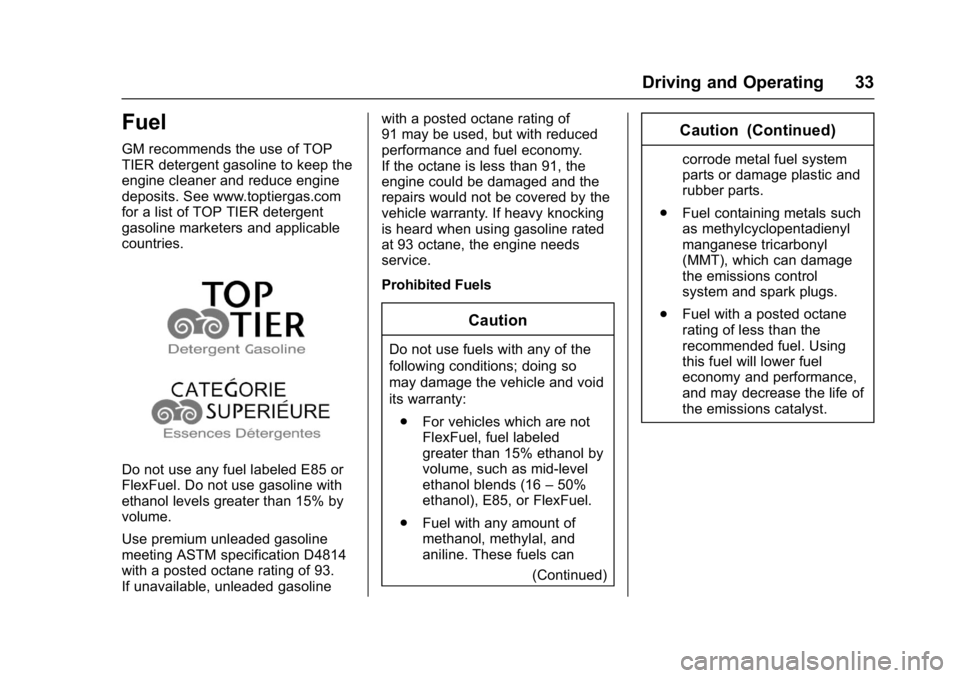
Chevrolet Camaro High Performance Owner Manual Supplemen (GMNA-
Localizing-U.S./Canada/Mexico-11348335) - 2018 - CRC - 4/5/17
Driving and Operating 33
Fuel
GM recommends the use of TOP
TIER detergent gasoline to keep the
engine cleaner and reduce engine
deposits. See www.toptiergas.com
for a list of TOP TIER detergent
gasoline marketers and applicable
countries.
Do not use any fuel labeled E85 or
FlexFuel. Do not use gasoline with
ethanol levels greater than 15% by
volume.
Use premium unleaded gasoline
meeting ASTM specification D4814
with a posted octane rating of 93.
If unavailable, unleaded gasolinewith a posted octane rating of
91 may be used, but with reduced
performance and fuel economy.
If the octane is less than 91, the
engine could be damaged and the
repairs would not be covered by the
vehicle warranty. If heavy knocking
is heard when using gasoline rated
at 93 octane, the engine needs
service.
Prohibited Fuels
Caution
Do not use fuels with any of the
following conditions; doing so
may damage the vehicle and void
its warranty:
. For vehicles which are not
FlexFuel, fuel labeled
greater than 15% ethanol by
volume, such as mid-level
ethanol blends (16 –50%
ethanol), E85, or FlexFuel.
. Fuel with any amount of
methanol, methylal, and
aniline. These fuels can
(Continued)
Caution (Continued)
corrode metal fuel system
parts or damage plastic and
rubber parts.
. Fuel containing metals such
as methylcyclopentadienyl
manganese tricarbonyl
(MMT), which can damage
the emissions control
system and spark plugs.
. Fuel with a posted octane
rating of less than the
recommended fuel. Using
this fuel will lower fuel
economy and performance,
and may decrease the life of
the emissions catalyst.
Page 35 of 53
Chevrolet Camaro High Performance Owner Manual Supplemen (GMNA-
Localizing-U.S./Canada/Mexico-11348335) - 2018 - CRC - 4/5/17
34 Vehicle Care
Vehicle Care
Vehicle Checks
Engine CompartmentOverview . . . . . . . . . . . . . . . . . . . . . 35
Engine Air Cleaner/Filter . . . . . . . 36
Cooling System . . . . . . . . . . . . . . . . 37
Engine Overheating . . . . . . . . . . . . 38
Wheels and Tires
Low-Profile Tires . . . . . . . . . . . . . . . 38
Summer Tires . . . . . . . . . . . . . . . . . . 38
Tire Pressure for High-Speed Operation . . . . . . . . . . . . . . . . . . . . 39
Jump Starting
Jump Starting - NorthAmerica . . . . . . . . . . . . . . . . . . . . . . 40
Towing the Vehicle
Towing the Vehicle . . . . . . . . . . . . . 40
Appearance Care
Exterior Care . . . . . . . . . . . . . . . . . . 41
Page 36 of 53
Chevrolet Camaro High Performance Owner Manual Supplemen (GMNA-
Localizing-U.S./Canada/Mexico-11348335) - 2018 - CRC - 4/5/17
Vehicle Care 35
Vehicle Checks
Engine Compartment Overview
Page 37 of 53
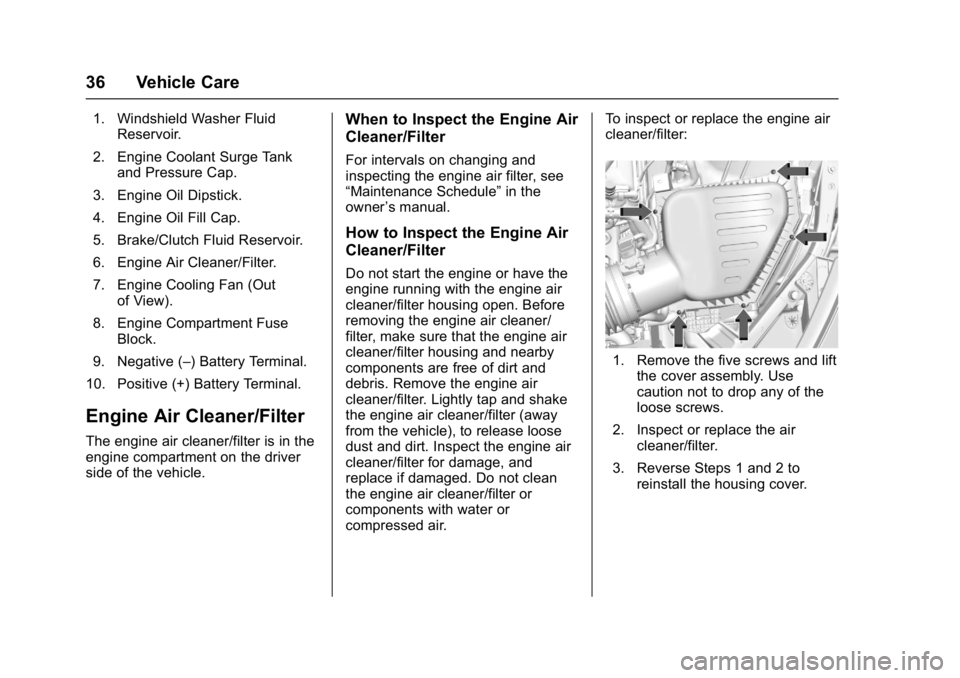
Chevrolet Camaro High Performance Owner Manual Supplemen (GMNA-
Localizing-U.S./Canada/Mexico-11348335) - 2018 - CRC - 4/5/17
36 Vehicle Care
1. Windshield Washer FluidReservoir.
2. Engine Coolant Surge Tank and Pressure Cap.
3. Engine Oil Dipstick.
4. Engine Oil Fill Cap.
5. Brake/Clutch Fluid Reservoir.
6. Engine Air Cleaner/Filter.
7. Engine Cooling Fan (Out of View).
8. Engine Compartment Fuse Block.
9. Negative (–) Battery Terminal.
10. Positive (+) Battery Terminal.
Engine Air Cleaner/Filter
The engine air cleaner/filter is in the
engine compartment on the driver
side of the vehicle.
When to Inspect the Engine Air
Cleaner/Filter
For intervals on changing and
inspecting the engine air filter, see
“Maintenance Schedule” in the
owner ’s manual.
How to Inspect the Engine Air
Cleaner/Filter
Do not start the engine or have the
engine running with the engine air
cleaner/filter housing open. Before
removing the engine air cleaner/
filter, make sure that the engine air
cleaner/filter housing and nearby
components are free of dirt and
debris. Remove the engine air
cleaner/filter. Lightly tap and shake
the engine air cleaner/filter (away
from the vehicle), to release loose
dust and dirt. Inspect the engine air
cleaner/filter for damage, and
replace if damaged. Do not clean
the engine air cleaner/filter or
components with water or
compressed air. To inspect or replace the engine air
cleaner/filter:
1. Remove the five screws and lift
the cover assembly. Use
caution not to drop any of the
loose screws.
2. Inspect or replace the air cleaner/filter.
3. Reverse Steps 1 and 2 to reinstall the housing cover.
Page 38 of 53
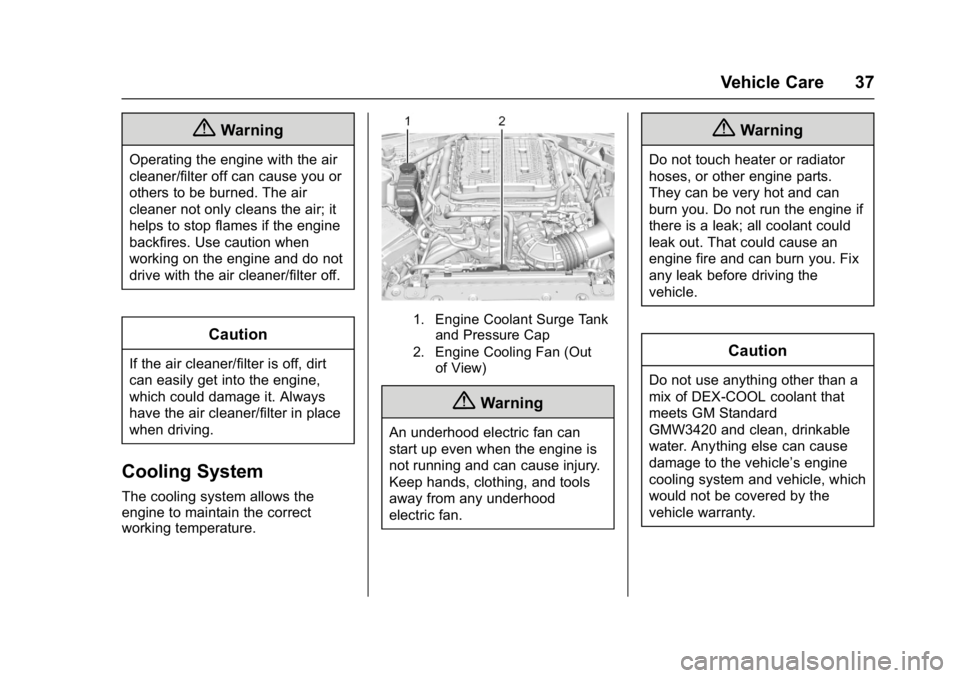
Chevrolet Camaro High Performance Owner Manual Supplemen (GMNA-
Localizing-U.S./Canada/Mexico-11348335) - 2018 - CRC - 4/5/17
Vehicle Care 37
{Warning
Operating the engine with the air
cleaner/filter off can cause you or
others to be burned. The air
cleaner not only cleans the air; it
helps to stop flames if the engine
backfires. Use caution when
working on the engine and do not
drive with the air cleaner/filter off.
Caution
If the air cleaner/filter is off, dirt
can easily get into the engine,
which could damage it. Always
have the air cleaner/filter in place
when driving.
Cooling System
The cooling system allows the
engine to maintain the correct
working temperature.
1. Engine Coolant Surge Tankand Pressure Cap
2. Engine Cooling Fan (Out of View)
{Warning
An underhood electric fan can
start up even when the engine is
not running and can cause injury.
Keep hands, clothing, and tools
away from any underhood
electric fan.
{Warning
Do not touch heater or radiator
hoses, or other engine parts.
They can be very hot and can
burn you. Do not run the engine if
there is a leak; all coolant could
leak out. That could cause an
engine fire and can burn you. Fix
any leak before driving the
vehicle.
Caution
Do not use anything other than a
mix of DEX-COOL coolant that
meets GM Standard
GMW3420 and clean, drinkable
water. Anything else can cause
damage to the vehicle’ s engine
cooling system and vehicle, which
would not be covered by the
vehicle warranty.
Page 39 of 53
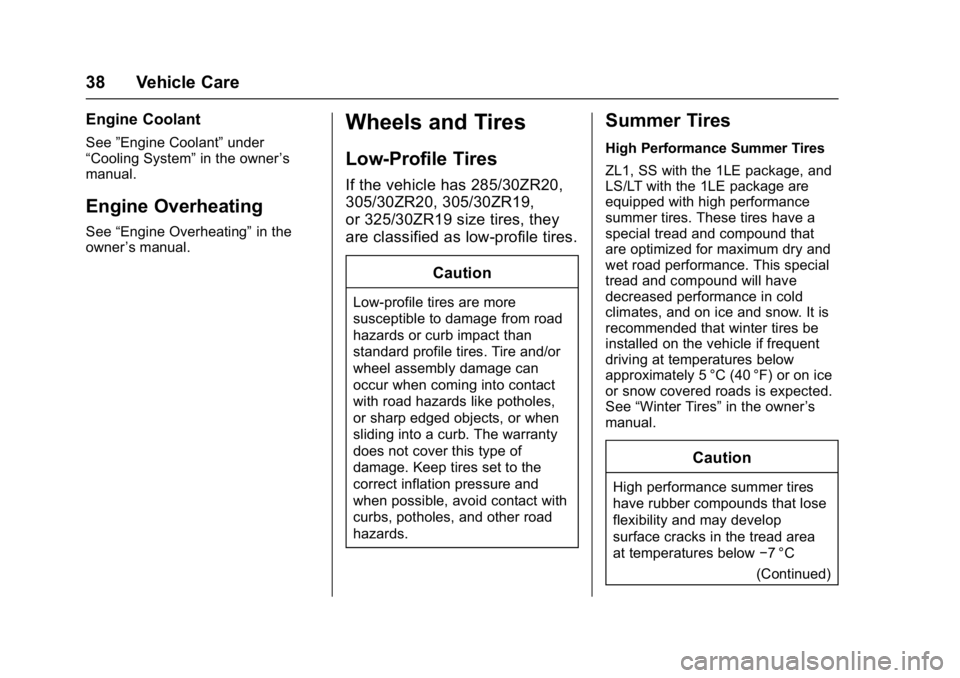
Chevrolet Camaro High Performance Owner Manual Supplemen (GMNA-
Localizing-U.S./Canada/Mexico-11348335) - 2018 - CRC - 4/5/17
38 Vehicle Care
Engine Coolant
See”Engine Coolant” under
“Cooling System” in the owner’s
manual.
Engine Overheating
See “Engine Overheating” in the
owner ’s manual.
Wheels and Tires
Low-Profile Tires
If the vehicle has 285/30ZR20,
305/30ZR20, 305/30ZR19,
or 325/30ZR19 size tires, they
are classified as low-profile tires.
Caution
Low-profile tires are more
susceptible to damage from road
hazards or curb impact than
standard profile tires. Tire and/or
wheel assembly damage can
occur when coming into contact
with road hazards like potholes,
or sharp edged objects, or when
sliding into a curb. The warranty
does not cover this type of
damage. Keep tires set to the
correct inflation pressure and
when possible, avoid contact with
curbs, potholes, and other road
hazards.
Summer Tires
High Performance Summer Tires
ZL1, SS with the 1LE package, and
LS/LT with the 1LE package are
equipped with high performance
summer tires. These tires have a
special tread and compound that
are optimized for maximum dry and
wet road performance. This special
tread and compound will have
decreased performance in cold
climates, and on ice and snow. It is
recommended that winter tires be
installed on the vehicle if frequent
driving at temperatures below
approximately 5 °C (40 °F) or on ice
or snow covered roads is expected.
See“Winter Tires” in the owner’s
manual.
Caution
High performance summer tires
have rubber compounds that lose
flexibility and may develop
surface cracks in the tread area
at temperatures below −7 °C
(Continued)
Page 40 of 53
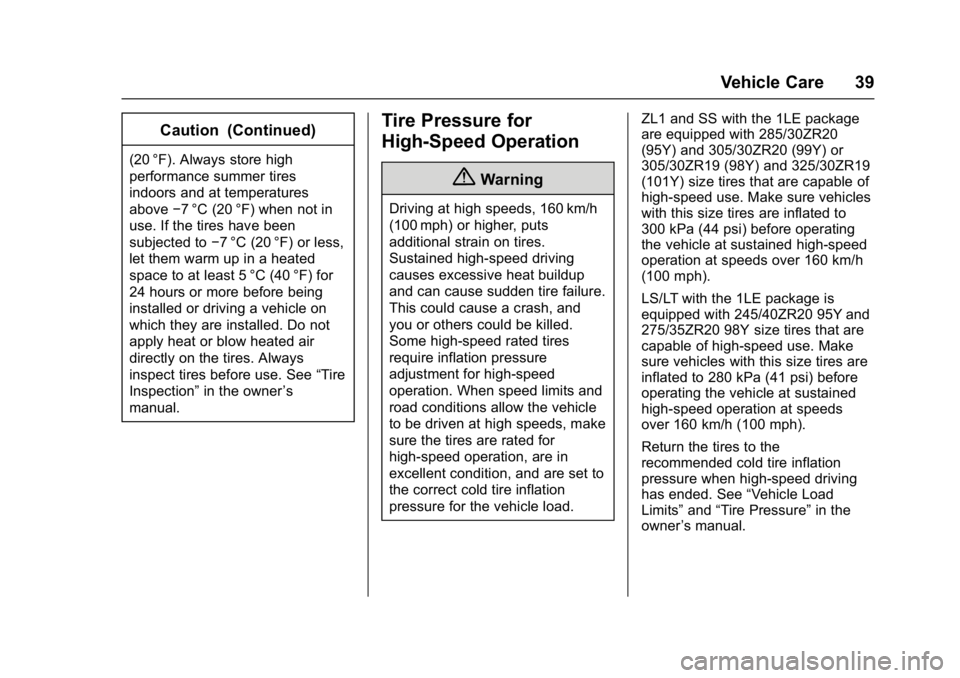
Chevrolet Camaro High Performance Owner Manual Supplemen (GMNA-
Localizing-U.S./Canada/Mexico-11348335) - 2018 - CRC - 4/5/17
Vehicle Care 39
Caution (Continued)
(20 °F). Always store high
performance summer tires
indoors and at temperatures
above−7 °C (20 °F) when not in
use. If the tires have been
subjected to −7 °C (20 °F) or less,
let them warm up in a heated
space to at least 5 °C (40 °F) for
24 hours or more before being
installed or driving a vehicle on
which they are installed. Do not
apply heat or blow heated air
directly on the tires. Always
inspect tires before use. See “Tire
Inspection” in the owner ’s
manual.
Tire Pressure for
High-Speed Operation
{Warning
Driving at high speeds, 160 km/h
(100 mph) or higher, puts
additional strain on tires.
Sustained high-speed driving
causes excessive heat buildup
and can cause sudden tire failure.
This could cause a crash, and
you or others could be killed.
Some high-speed rated tires
require inflation pressure
adjustment for high-speed
operation. When speed limits and
road conditions allow the vehicle
to be driven at high speeds, make
sure the tires are rated for
high-speed operation, are in
excellent condition, and are set to
the correct cold tire inflation
pressure for the vehicle load. ZL1 and SS with the 1LE package
are equipped with 285/30ZR20
(95Y) and 305/30ZR20 (99Y) or
305/30ZR19 (98Y) and 325/30ZR19
(101Y) size tires that are capable of
high-speed use. Make sure vehicles
with this size tires are inflated to
300 kPa (44 psi) before operating
the vehicle at sustained high-speed
operation at speeds over 160 km/h
(100 mph).
LS/LT with the 1LE package is
equipped with 245/40ZR20 95Y and
275/35ZR20 98Y size tires that are
capable of high-speed use. Make
sure vehicles with this size tires are
inflated to 280 kPa (41 psi) before
operating the vehicle at sustained
high-speed operation at speeds
over 160 km/h (100 mph).
Return the tires to the
recommended cold tire inflation
pressure when high-speed driving
has ended. See
“Vehicle Load
Limits” and“Tire Pressure” in the
owner ’s manual.